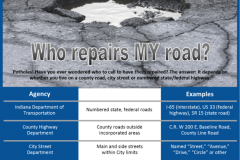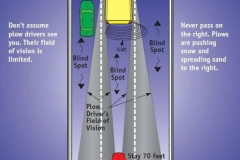
News release from INDOT:
INDOT’s Yellow Salt Trucks Deployed Ahead of Falling Temps
Snow Squalls Suddenly Degrade Visibility, Road Conditions
(February 8, 2016) – The Indiana Department of Transportation has 315 yellow salt trucks deployed as of this morning to patrol interstates, U.S. highways and state routes ahead of falling pavement temperatures and winter precipitation. A series of storms may drop up to 3 inches of snow across Indiana this week with additional lake-effect snow possible in the South Bend area.
INDOT maintenance supervisors will continue to monitor weather radar and forecasts, and adjust manpower, trucks and materials to address changes in forecasted and observed road conditions. Each plow route takes 2-3 hours to complete with salt assisting in melting between passes. Trained employees are on call to staff plow trucks around the clock with alternating shifts of 12 hours or more.
Snow squall warning
The National Weather Service office in Indianapolis says there is a potential for “snow squalls” this afternoon through Tuesday. Localized heavy snowfall combined with surface wind gusts up to 25 mph produce sudden reductions in road conditions and visibility with near whiteout conditions, which increase chances for multi-vehicle crashes.
Drivers who see a “wall” of snow ahead associated with a snow squall should immediately take the following steps to improve visibility and safety:
- Before you depart, fully clear off your front and rear windshields and side mirrors.
- Choose direct routes instead of longer trips on higher-speed roads and highways.
- Take your foot off the gas and turn off cruise control, especially on high-speed highways. No one should be traveling at interstate speeds during winter weather. Law enforcement will be writing citations for drivers going faster than conditions merit and putting others in harm’s way.
- Use your low-beam lamps if your vehicle is equipped.
- Increase following distance so you can barely see the taillights of any vehicles in front of you.
- Turn on emergency flashers if you are stopped or traveling slower than other vehicles.
- If you need to stop, try to exit or turn off the main highway. If you must stop on the shoulders, pull as far away from the travel lanes as possible.
- Regularly fill your gas tank and charge your mobile phone.
- Apply anti-lock brakes firmly. Pump brakes that are not anti-lock.
- Do not overcorrect with steering.
Low temperatures
Temperatures are expected to drop well below freezing by Tuesday night, requiring road salt to work harder to melt snow and ice. Granular salt helps to add traction while lowering the temperature at which the ice melts. INDOT may mix road salt with sand or specialty chemicals that help it work more effectively in these conditions.
Sub-freezing temperatures increase the chances of melt-water refreezing into “black ice” or “slick spots” that may be difficult for drivers to distinguish from dry pavement. Areas that receive less direct sunlight are common places for slick spots. Even four-wheel-drive vehicles and large trucks are no match if all tires are on ice.
Know before you go
There are several state resources that drivers can access to “know before you go”:
- Counties post travel advisories as new information is available to in.gov/dhs/ or the Indiana Travel Advisory app for iPhone or Android.
- INDOT maintenance staff report color-coded winter driving conditions on INDOT’s TrafficWise map at https://indot.carsprogram.org. Road conditions are defined as: (1) Gray: Good, the road is clear (2) Blue: Fair, speed is reduced due to isolated patches of snow and ice, and (3) Violet: Difficult or hazardous, speed is reduced due to snow and/or ice covered pavement
- Dial INDOT’s hotline toll-free at 1-800-261-ROAD (7623) or 511 from a mobile phone.
- Find your regional INDOT district on Facebook and Twitter at https://in.gov/indot/3074.htm.








